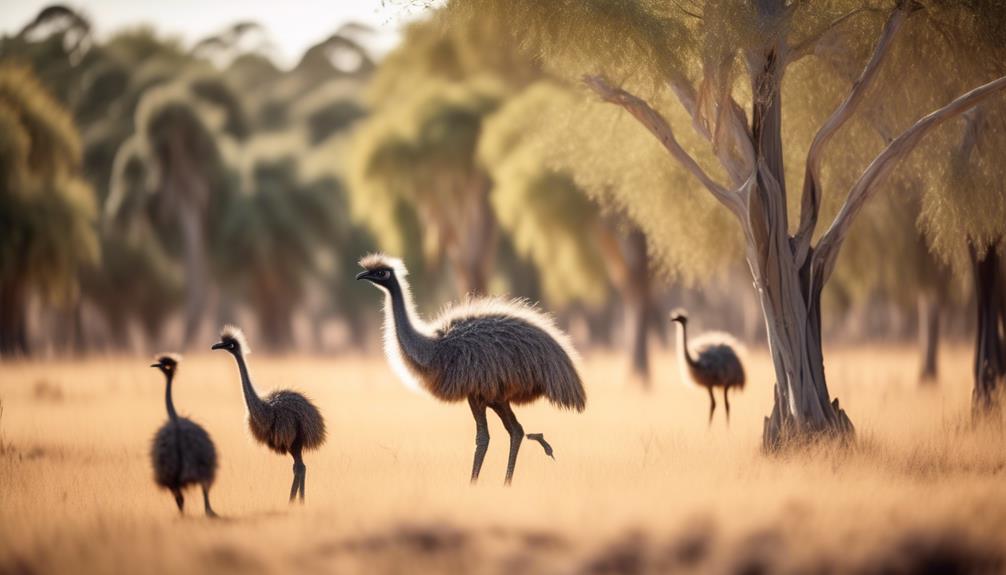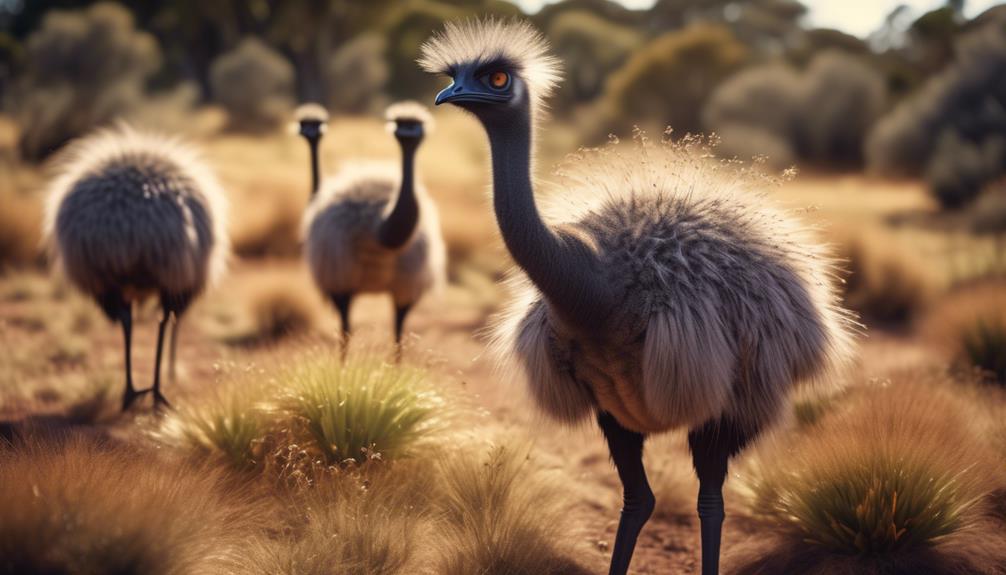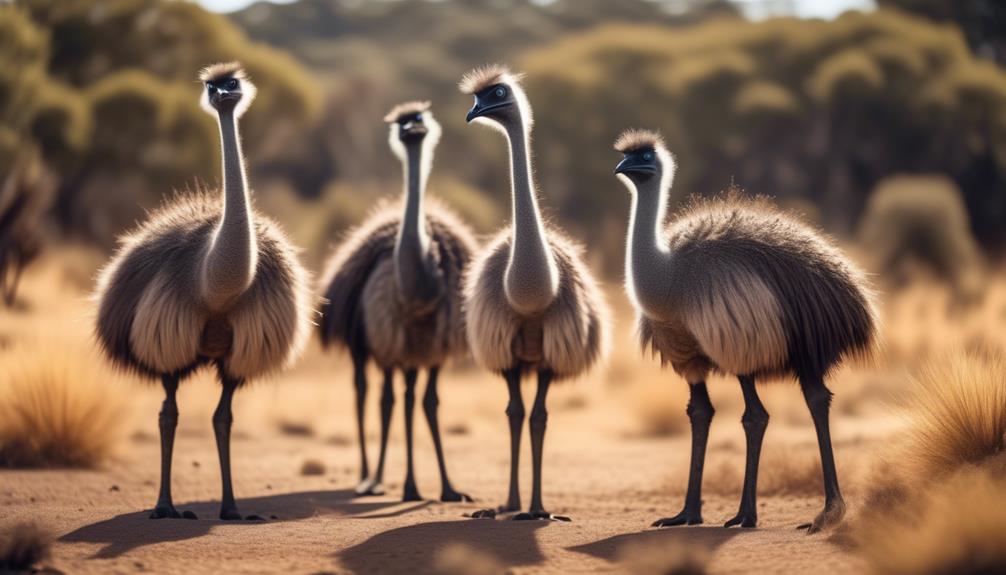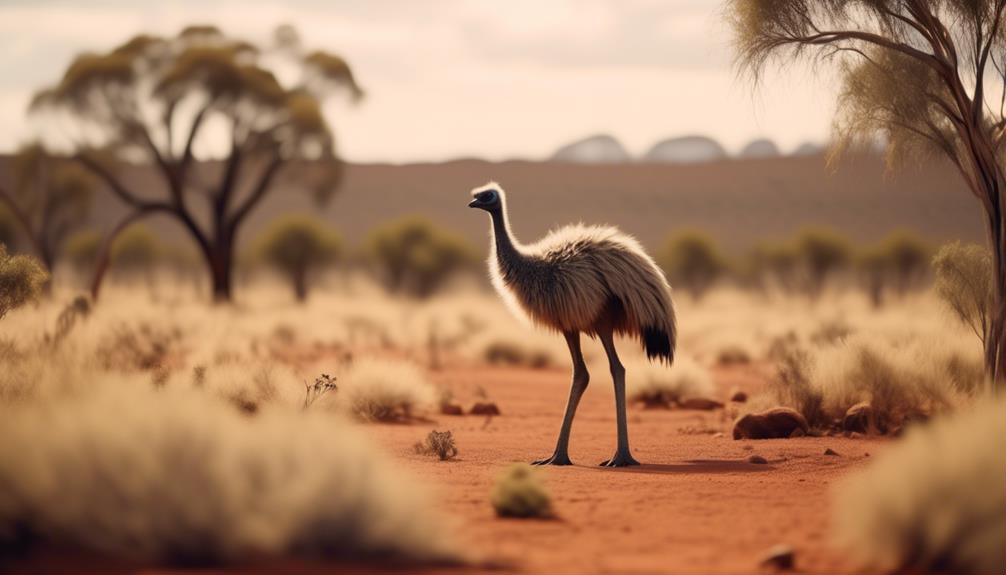
Did you know that emus, those large flightless birds native to Australia, play a vital role in maintaining the health of ecosystems? With their unique characteristics and behaviors, emus have a significant impact on biodiversity.
From serving as seed dispersers and plant regenerators to influencing animal populations and controlling invasive species, these birds contribute to the overall balance and stability of their habitats.
However, recent declines in emu populations have raised concerns about the potential consequences for ecosystem health. In this discussion, we will explore the fascinating relationship between emus and biodiversity, uncovering the crucial role they play in sustaining the delicate balance of our natural ecosystems.
Emus: A Keystone Species in Ecosystems

Emus play a crucial role as keystone species in various ecosystems due to their significant impact on biodiversity. As ecosystem engineers, emus shape their surroundings in ways that have far-reaching effects on the overall health and functioning of ecosystems. One of the most notable ways in which emus influence their environment is through their relationship with fire dynamics.
Emus have a unique ability to modify the landscape by consuming vegetation and creating open spaces. These open spaces, in turn, serve as firebreaks, preventing the spread of wildfires and reducing their intensity. By selectively feeding on dry grasses and shrubs, emus create areas of low fuel load, making it more difficult for fires to ignite and spread. This behavior contributes to the overall fire resilience of ecosystems where emus are present.
Moreover, emus have been observed to actively seek out recently burned areas. They're known to feed on the fresh regrowth that emerges after a fire, effectively controlling the vegetation and preventing it from becoming too dense. This helps maintain a balance in plant communities and promotes the growth of a diverse range of species.
Emus and Their Role in Maintaining Biodiversity
The impact of emus as keystone species extends beyond their influence on fire dynamics, encompassing their crucial role in maintaining biodiversity within ecosystems. Emus play a vital part in preserving ecological balance and promoting ecosystem resilience. Here are two reasons why their role in maintaining biodiversity is of utmost importance:
- Emus as seed dispersers: Emus have a unique ability to consume and disperse a wide variety of plant seeds. As they move across the landscape, their digestive system breaks down the seeds, aiding in their germination and dispersal to new areas. This process helps to maintain healthy plant populations, ensuring a diverse range of species and promoting overall ecosystem health.
- Emus as ecosystem engineers: Emus are known for their foraging behavior, which involves digging up the ground in search of food. This activity creates patches of disturbed soil, exposing bare ground and encouraging the growth of different plant species. These patches diversify the habitat, providing niches for a range of organisms such as insects, small mammals, and reptiles. By acting as ecosystem engineers, emus contribute to the overall resilience of the ecosystem.
Emus' influence on maintaining biodiversity highlights their significance in ecosystem functioning and health. Their role as seed dispersers and ecosystem engineers demonstrates the intricate web of interactions that exist within ecosystems, and emphasizes the need to protect and conserve these unique and important species.
Emus as Seed Dispersers and Plant Regenerators

Seed dispersal and plant regeneration are critical ecological functions facilitated by emus. Emus, with their unique foraging behavior, play a vital role in the dispersal of seeds and the regeneration of plant populations in their habitats.
As emus roam across vast areas, they consume a wide variety of plant species, including fruits, seeds, and vegetation. While feeding, emus inadvertently ingest seeds from different plants, which then pass through their digestive system. The seeds are protected by the robust emu digestive system and are deposited in their droppings over a large area. This dispersal mechanism enhances the chances of seed germination and colonization in new locations.
Additionally, emus have a profound impact on soil fertility through their foraging behavior. As they feed, emus disturb the soil, aiding in the decomposition of plant matter and the recycling of nutrients. This disturbance increases soil aeration and nutrient availability, creating favorable conditions for plant growth.
Furthermore, emu droppings contribute to soil fertility by enriching it with organic matter and essential nutrients.
Emus' Impact on Vegetation and Habitat Modification
Through their foraging behavior and habitat modification, emus have a significant impact on the vegetation and overall structure of their habitats. Emus play a crucial role in shaping the landscape and influencing the biodiversity of their environment. Here are two key ways in which emus affect their habitats:
- Emus and soil erosion:
Emus have long, powerful legs that allow them to move quickly across the land. As they walk, they disturb the soil, which can lead to erosion. This can be particularly problematic in areas where the soil is already vulnerable to erosion, such as slopes or areas with little vegetation cover. The movement of emus can accelerate soil erosion, potentially leading to the degradation of the habitat.
- Emus and fire ecology:
Fire is an important ecological process in many ecosystems, and emus have a unique relationship with fire. Emus are known to actively seek out recently burned areas, as these areas provide an abundance of fresh vegetation and insects. By foraging in these areas, emus help to control the vegetation and reduce the risk of further fires. Their presence also helps to disperse seeds, promoting the regeneration of plant species in fire-affected areas.
Emus and Their Influence on Animal Populations

As emus shape their habitats through their foraging behavior and habitat modification, their presence also has an impact on the populations of other animals. Emus play a significant role in predator-prey dynamics within their ecosystems. As large herbivores, they can serve as a potential food source for predators such as dingoes and feral dogs. This interaction creates a delicate balance, where emus act as prey and predators maintain their population through predation. Emus' ability to outrun their predators with their impressive speed and agility contributes to their survival and the maintenance of predator-prey dynamics.
Additionally, emus compete with other herbivores for resources within their habitats. Their browsing behavior can impact the availability of food sources for smaller herbivores such as kangaroos and wallabies. This competition for food resources can lead to changes in the population dynamics of these herbivores, influencing their distribution and abundance.
Understanding the influence of emus on animal populations is crucial for maintaining the overall health and balance of ecosystems. Emus' presence contributes to the complex web of interactions between species, shaping the biodiversity and functioning of the ecosystem.
Further research is needed to fully comprehend the extent of emus' influence on animal populations and to develop effective conservation strategies that consider the ecological role of these fascinating creatures.
Emus and the Control of Invasive Species
Emus play a crucial role in the control of invasive species within their ecosystems. These magnificent birds have been recognized as effective biocontrol agents, helping to manage and regulate the populations of invasive species in their habitats. Here are some key points to consider:
- Emus actively hunt and consume a wide variety of invasive species, such as rabbits, feral pigs, and European carp. This helps to reduce the impact that these invaders have on native flora and fauna.
- Emus' voracious appetite and ability to cover large distances make them efficient predators of invasive species.
- By targeting invasive species, emus prevent them from outcompeting native species for resources, helping to maintain biodiversity.
- Emus contribute to the health of ecosystems by controlling invasive species populations. This helps to restore balance and stability to the ecosystem, allowing native species to thrive.
- The presence of emus can lead to a decrease in the abundance and distribution of invasive species, which in turn benefits the overall ecosystem health.
- Emus' natural behavior of foraging and hunting helps to keep invasive species in check, reducing their negative impact on the environment.
Emus' role as biocontrol agents in invasive species management is a valuable asset in ensuring the long-term health and sustainability of ecosystems. Their ability to control invasive species populations contributes to the preservation of biodiversity and the overall well-being of the environment.
The Conservation Implications of Emu Decline or Extinction

The decline or extinction of emus could have significant conservation implications for their ecosystems. Emus play a crucial role in maintaining ecological balance, and their absence may disrupt the delicate harmony within their habitats. Conservation strategies must be implemented to mitigate the potential negative impacts.
Emus are herbivorous animals that primarily consume grasses, seeds, and fruits. Their feeding habits help control the growth of vegetation, preventing the overgrowth of certain plant species and promoting the diversity of plant communities. Without emus, there's a risk of unchecked vegetation growth, which could lead to the dominance of certain plant species and the suppression of others. This could have a cascading effect on other organisms dependent on specific plants for food and shelter.
Furthermore, emus contribute to nutrient cycling by dispersing seeds through their droppings. This aids in the regeneration and dispersal of plant species, promoting biodiversity. The decline or extinction of emus could disrupt this process, resulting in a decline in plant diversity and subsequent impacts on other organisms, such as insects, birds, and small mammals, that rely on specific plants for survival.
To ensure the conservation of emus and the maintenance of ecological balance, conservation strategies must focus on protecting their habitats, reducing threats such as habitat loss and fragmentation, and implementing measures to mitigate the impact of invasive species. By safeguarding emu populations, we can help preserve the intricate web of life that depends on their presence.
Frequently Asked Questions
What Is the Average Lifespan of an Emu and How Does It Affect the Biodiversity of Ecosystems?
The average lifespan of an emu is approximately 10-20 years. Emu population dynamics, including lifespan, can have a significant impact on the biodiversity of ecosystems, influencing species interactions and overall ecosystem health.
Are There Any Negative Effects of Emus as Seed Dispersers and Plant Regenerators?
Emus as seed dispersers and plant regenerators can have negative effects on ecosystems. They can compete with native species and alter the composition of plant communities, which can disrupt the balance of biodiversity.
How Do Emus Impact Vegetation and Habitat Modification in Different Ecosystems?
Emus, through their grazing patterns, can have a significant impact on vegetation and habitat modification in various ecosystems. Their feeding behavior influences plant regrowth and distribution, while also affecting soil fertility.
Do Emus Have Any Specific Influence on the Populations of Endangered Animal Species?
Emus, with their unique influence on predator-prey dynamics and role in controlling invasive species, have the potential to impact the populations of endangered animal species. Their presence warrants further study and consideration for effective biodiversity conservation.
What Are the Potential Consequences of Emu Decline or Extinction on the Conservation of Ecosystems?
The potential consequences of emu decline or extinction on ecosystem conservation are significant. Emu decline can disrupt the balance of species, leading to reduced biodiversity and negative impacts on the overall health and stability of ecosystems.
Conclusion
In conclusion, the decline or extinction of emus would have significant conservation implications for ecosystem health.
Despite their seemingly mundane presence, these remarkable birds play a crucial role as keystone species in maintaining biodiversity. Their unique ability to disperse seeds and regenerate plants ensures the survival of various species.
Furthermore, emus' impact on vegetation and control of invasive species can't be overlooked. Therefore, it's essential to recognize the intricate web of connections that emus contribute to, as their absence would leave a void in the delicate balance of our ecosystems.




